STEREO/IMPACT Science
The solar wind is waves of highly energized electrons and protons that shoot out from the Sun. These highly charged particles interact with Earth's magnetosphere to produce beautiful auroras. Of course, solar winds do much more than just create auroras, they are the driving force of many interplanetary interactions between the Sun and the Earth. STEREO studies such interactions and here's how:
The 3-Dimentional Structure of the Corona and Solar Wind
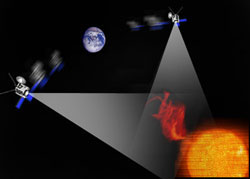 The two STEREO spacecrafts use a series of lunar swing-bys achieve ideal orbit. One spacecraft races ahead of the Earth, following a heliocentric orbits lightly smaller than Earth's path, and the other spacecraft lags behind Earth, also following a heliocentric orbit but slightly larger than Earth's path. These spacecrafts are constantly becoming furthur and further away from each other. They seperate at a rate of about 22 degree per year. The twin STEREO spacecraft offer the possibility of relating features seen by the coronagraph on one spacecraft with structure in the slow solar wind detected by IMPACT on the other.
The two STEREO spacecrafts use a series of lunar swing-bys achieve ideal orbit. One spacecraft races ahead of the Earth, following a heliocentric orbits lightly smaller than Earth's path, and the other spacecraft lags behind Earth, also following a heliocentric orbit but slightly larger than Earth's path. These spacecrafts are constantly becoming furthur and further away from each other. They seperate at a rate of about 22 degree per year. The twin STEREO spacecraft offer the possibility of relating features seen by the coronagraph on one spacecraft with structure in the slow solar wind detected by IMPACT on the other.
Getting a 3D Perspective
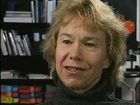 With two eyes, we can perceive depth. With two satellites we can imitate our eyes and image the Sun in 3-D. In this short interview, IMPACT Principal Investigator Dr. Janet Luhmann tells us about the benefit of using two spacecraft to study Coronal Mass Ejections. Images from two spacecraft can provide a three-dimensional view of the CME as it travels through the steady solar wind.
With two eyes, we can perceive depth. With two satellites we can imitate our eyes and image the Sun in 3-D. In this short interview, IMPACT Principal Investigator Dr. Janet Luhmann tells us about the benefit of using two spacecraft to study Coronal Mass Ejections. Images from two spacecraft can provide a three-dimensional view of the CME as it travels through the steady solar wind.
Video Problems? Get the latest QuickTime plug-in here
(2.47 MB, .mov)
Solar Energetic Particle Events
 Solar wind and CME's shoot out plasma at such speed that it produces a shockwave. This shockwave then furthur accelerates these particles. In this short interview, IMPACT Principal Investigator Dr. Janet Luhmann tells us how particles in the solar wind accelerate to dangerous speeds when a CME heads toward Earth. She explains the timing of the different parts of the CME: first these very fast particles, solar energetic particles (SEPs), reach Earth. Next, the CME arrives with the slower relatively high density particles and magnetic fields
Solar wind and CME's shoot out plasma at such speed that it produces a shockwave. This shockwave then furthur accelerates these particles. In this short interview, IMPACT Principal Investigator Dr. Janet Luhmann tells us how particles in the solar wind accelerate to dangerous speeds when a CME heads toward Earth. She explains the timing of the different parts of the CME: first these very fast particles, solar energetic particles (SEPs), reach Earth. Next, the CME arrives with the slower relatively high density particles and magnetic fields
Video Problems? Get the latest QuickTime plug-in here
(5.91 MB, .mov)
SEP (Solar Energetic Particles) Acceleration and Transport
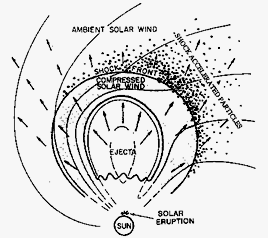 (IMPACT diagnostics of solar energetic particle (SEP) sources and CME connections.) IMPACT investigation will allow in-depth analysis of flare acceleration process signatures for contrast with ICME acceleration signatures. SEP electrons and radio bursts can be compared at two points. Mapping the onset times back to the Sun, we can remotely probe the structure of the injection site. STEREO IMPACT provides the opportunity to study abundances with SEP composition measurements.
(IMPACT diagnostics of solar energetic particle (SEP) sources and CME connections.) IMPACT investigation will allow in-depth analysis of flare acceleration process signatures for contrast with ICME acceleration signatures. SEP electrons and radio bursts can be compared at two points. Mapping the onset times back to the Sun, we can remotely probe the structure of the injection site. STEREO IMPACT provides the opportunity to study abundances with SEP composition measurements.
Interplanetary Coronal Mass Ejection CME/ICME
Coronal Mass Ejections are not entirely understood. During CME's, large quantities of plasma is ejected from the Sun's coronalsphere. These CME's are also accompanied by significant electromagentic wave disruptions. They are associated with solar flares, though how they are related is not yet clear. CME is the most powerful space-weather disturbance. Its electromagnetic storm and radiation changes the Earth's magnetosphere shape and can cause power outages and destroy satellite communications.
 (Understanding how CME's evolve between the Sun and 1 AU with IMPACT.) Questions about ICME evolution left unanswered because of the incompleteness of Sun-to-1 AU observations and models can be addressed by STEREO with IMPACT.
(Understanding how CME's evolve between the Sun and 1 AU with IMPACT.) Questions about ICME evolution left unanswered because of the incompleteness of Sun-to-1 AU observations and models can be addressed by STEREO with IMPACT.
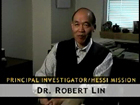 (IMPACT will help to solve the problem of CME genesis). IMPACT observations test models that predict how ICMEs from various CME generation mechanisms should differ. What is a Coronal Mass Ejection (CME)? The HESSI satellite's Principal Investigator Bob Lin explains (11.2 MB, .mov).
(IMPACT will help to solve the problem of CME genesis). IMPACT observations test models that predict how ICMEs from various CME generation mechanisms should differ. What is a Coronal Mass Ejection (CME)? The HESSI satellite's Principal Investigator Bob Lin explains (11.2 MB, .mov).
Coupling to Earth
 Ground magnetic perturbations, levels of ionospheric disturbance, and auroral activity are just a few of the commonly used measures of the "geoeffectiveness" of interplanetary conditions. IMPACT observations in the STEREO configuration with an ever-widening baseline between spacecraft provide a controlled experiment for solar wind structures, including ICMEs and solar wind stream features.
Ground magnetic perturbations, levels of ionospheric disturbance, and auroral activity are just a few of the commonly used measures of the "geoeffectiveness" of interplanetary conditions. IMPACT observations in the STEREO configuration with an ever-widening baseline between spacecraft provide a controlled experiment for solar wind structures, including ICMEs and solar wind stream features.
The Solar Magnetic Flux Cycle
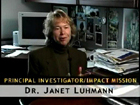 IMPACT magnetometer measurements during the ascending phase of next solar cycle(24) allow comparisons of the properties of the transient fields with those obtained by WIND during the previous cycle ascent and decline providing an improved basis for comparisons with solar dynamo models and their coronal counterparts. What are solar cycles and what is solar maximum about? Impact's Principal Investigator Janet Luhmann answers these questions and more in this short video clip (8.76 MB, .mov).
IMPACT magnetometer measurements during the ascending phase of next solar cycle(24) allow comparisons of the properties of the transient fields with those obtained by WIND during the previous cycle ascent and decline providing an improved basis for comparisons with solar dynamo models and their coronal counterparts. What are solar cycles and what is solar maximum about? Impact's Principal Investigator Janet Luhmann answers these questions and more in this short video clip (8.76 MB, .mov).
Video Problems? Get the latest QuickTime plug-in here
Latest Articles on STEREO mission
Anatomy of a Coronal Mass Ejection: Briefing Material (HTML article published at NASA.gov)
- 14 April 2009
Join STEREO and Explore Gravitational "Parking Lots" That May Hold Secret of Moon's Origin (HTML article published at NASA.gov)
- 9 April 2009
STEREO in Quadrature (HTML article published at NASA.gov)
- 28 January 2009



